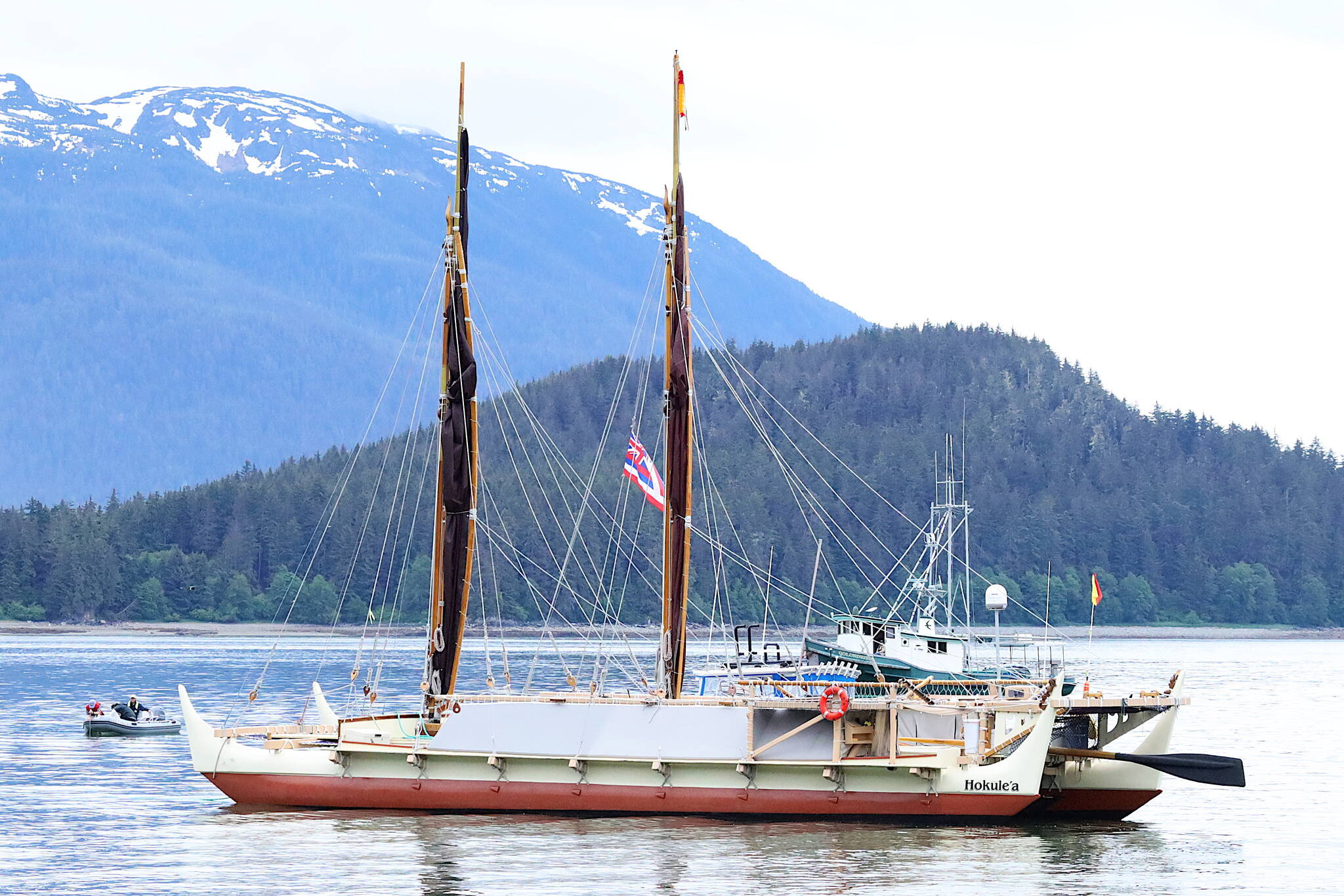This story has been updated with a video from a crew member and additional details.
It didn’t sail out of Juneau under cover of darkness, since the sun is already up at 4:15 a.m. a few days before summer solstice in Juneau, but Sunday’s departure of the Hōkūle‘a to begin its scheduled 47-month Pacific Ocean voyage was far quieter than its arrival a week ago.
The wind-powered traditional Polynesian voyaging canoe sailed quietly out of Statter Harbor with a calm sea and sky, and without the hundreds of well-wishers and media coverage that greeted the vessel during a June 11 welcoming ceremony. The voyage was scheduled to begin with a similarly high-profile departure ceremony on Thursday, but poor weather delayed the launch until crew members felt conditions were suitable.
During their week in Juneau, the crew took part in a multitude of activities with local tribal officials as well as providing tours of the Hōkūle‘a to visitors. Local leaders went ahead with their planned departure blessing during a ceremony moved indoors on Thursday as the crew members waited for sailing conditions to improve.
The weather cleared on Saturday and the crew took the Hōkūle‘a out on a training sail Saturday afternoon, according to Sonja Swenson Rogers, a spokesperson for the Polynesian Voyaging Society, which is organizing the voyage. The crew then tentatively planned to depart for their nearly four-year trip at 5 a.m. Sunday.
“They actually departed at 4:15 am, so 45 minutes earlier than expected,” she wrote in an email Sunday morning. As with other scheduled stops in Southeast Alaska during the next few weeks and then beyond, “the times of departure and arrival can change at the last moment.”
A 47-second video by a crew member aboard the Hōkūle‘a after its departure, thanking people in Juneau, was shared with the media by the Polynesian Voyaging Society on Sunday evening.
The voyage — called the Moananuiākea — seeks to circumnavigate 43,000 nautical miles of the Pacific Ocean, traveling to unite the hundreds of Indigenous communities that are connected by the Pacific Ocean, and amplify the importance of oceans and Indigenous knowledge.
The Hōkūle‘a reached Angoon at about 4:30 p.m. Sunday and is scheduled to remain there until Tuesday or Wednesday, according to Rogers. A map showing the vessel’s location and updates about the voyage are available at the Polynesian Voyaging Society’s website.
Among the events the crew is scheduled to participate in while in Angoon is a launch Monday of the first dugout canoe carved there since the community was bombarded by the U.S. Navy in 1882, according to a press release by Mary Catharine Martin, a spokesperson for SalmonState.
“The event, and the creation and dedication of this canoe, is a celebration of Angoon’s resilience, survival and future,” the release states. As with the visit of the Hōkūle‘a’s crew to Juneau, cultural exchanges featuring dancing, singing, gifts, and food are planned.
Prior to arriving in Juneau, the Hōkūle‘a completed Alaska Heritage Sail which paid homage to Alaska Natives, and places involved in the 31-year history and relationship with Hawaiʻi’s voyaging community, according to the Polynesian Voyaging Society. Stops included Yakutat, where Byron Mallot during the early 1990s enabled the donation of two 200-foot Sitka spruce logs to Hawaiʻi for the hulls of the voyaging canoe Hawaiʻiloa; Hoonah to honor former Sealaska Forestry Manager Ernie Hillman who led the cutting of the two trees, and Haines, home of the late Alaska Native elder Judson Brown.
According to Rogers, other scheduled stops for the Hōkūle‘a’ in Southeast Alaska are:
•Arrive in Kake on June 20 or 21, depart on June 24 (“give or take a day”).
• Arrive in Petersburg on June 24 and depart June 26.
• Arrive in Wrangell on June 26 and depart June 30.
• Arrive in Ketchikan June 30 and depart July 4 or 5.
• Arrive in Metlakatla on July 4 or 5 and depart July 8 or 9.
• Arrive in Hydaburg July 8 or 9 and depart July 15.
• Contact Mark Sabbatini at mark.sabbatini@juneauempire.com or (907) 957-2306.

